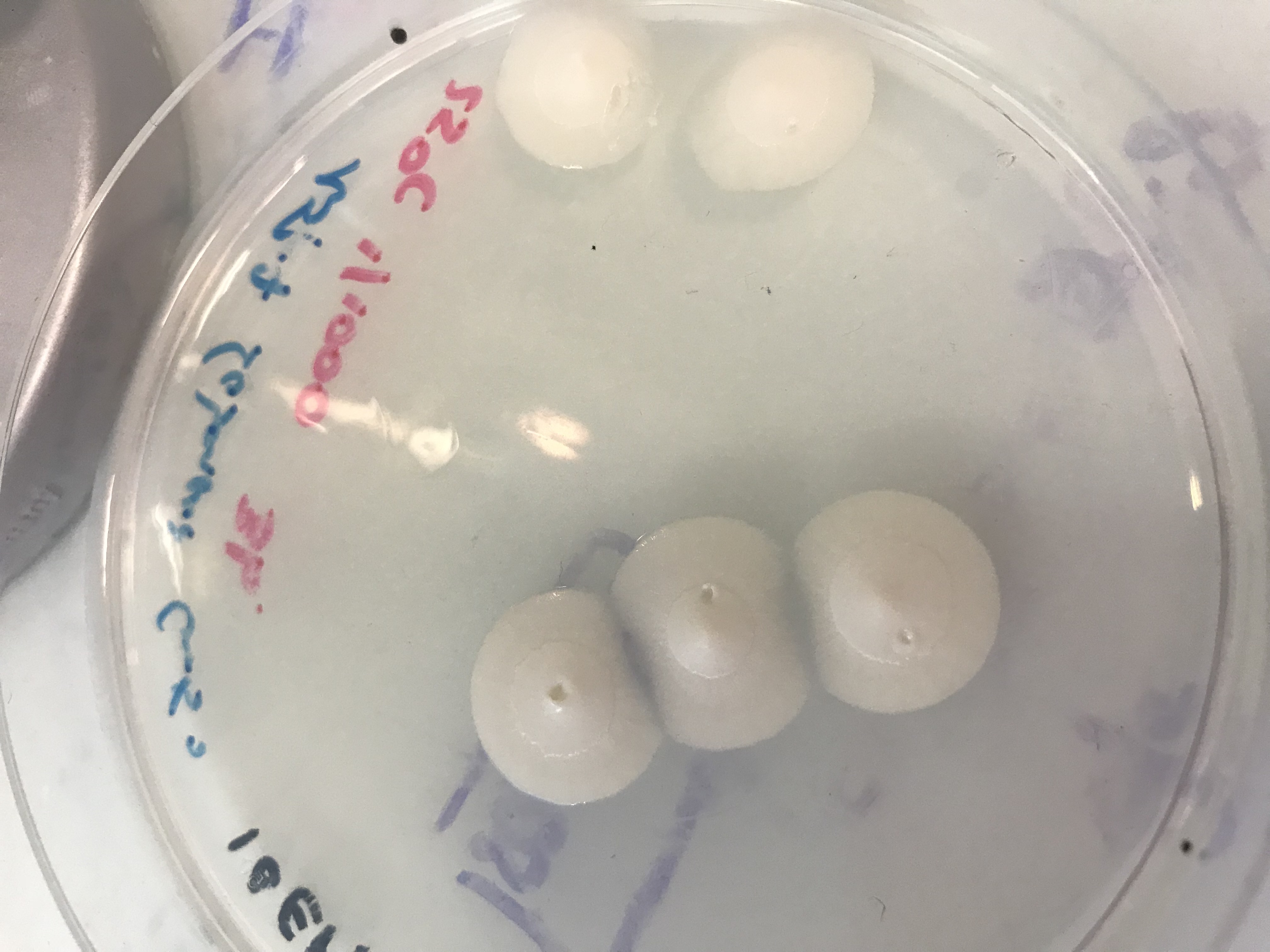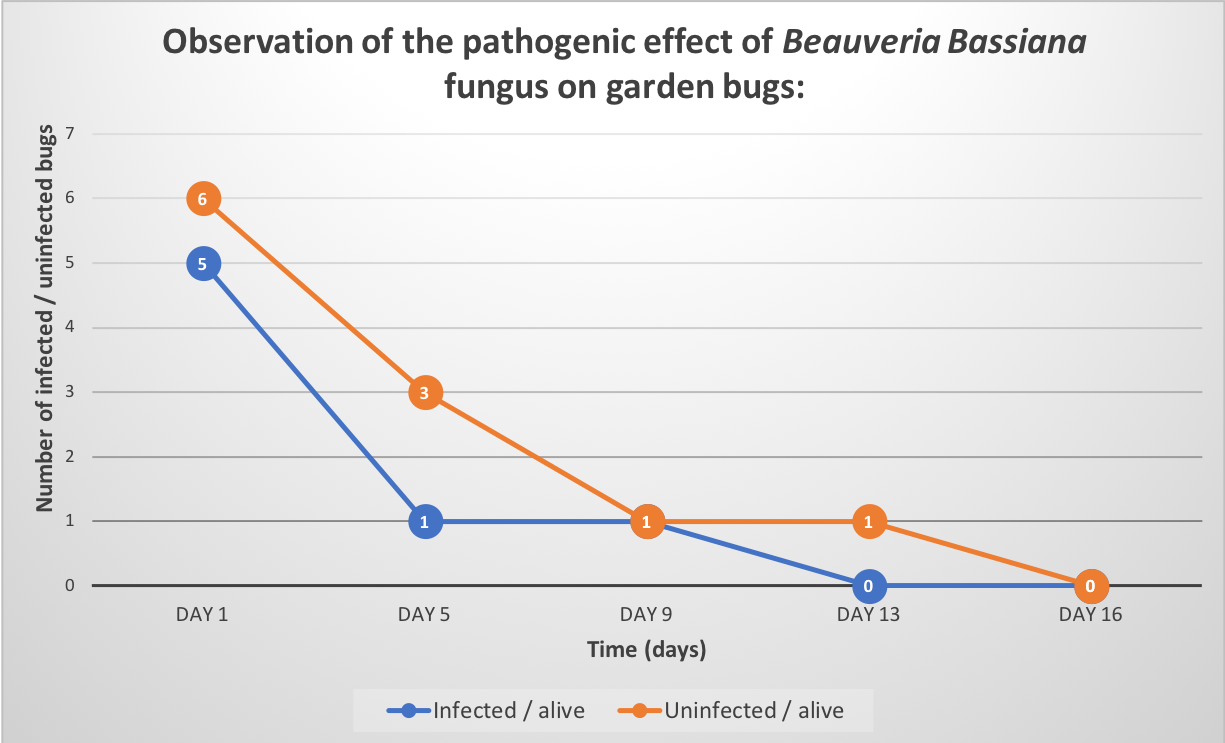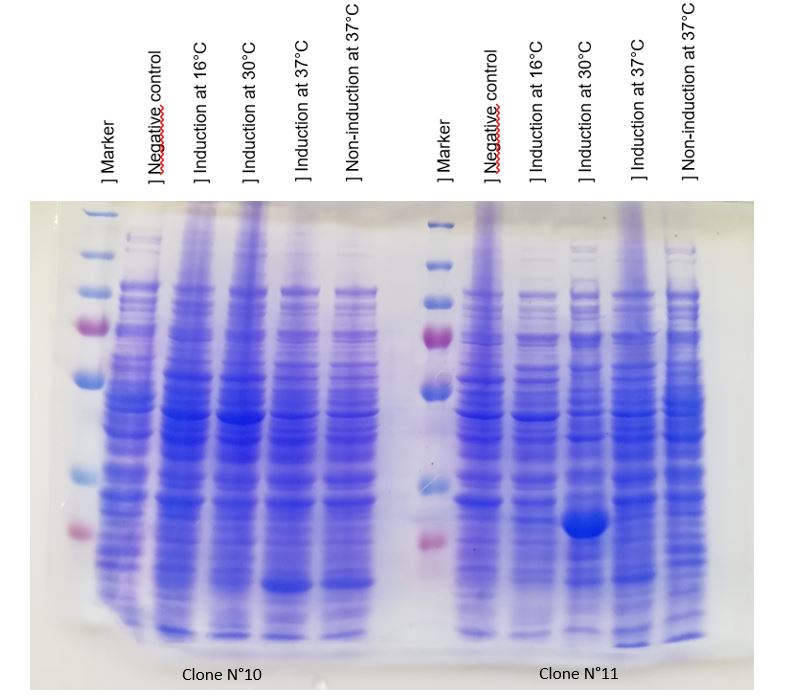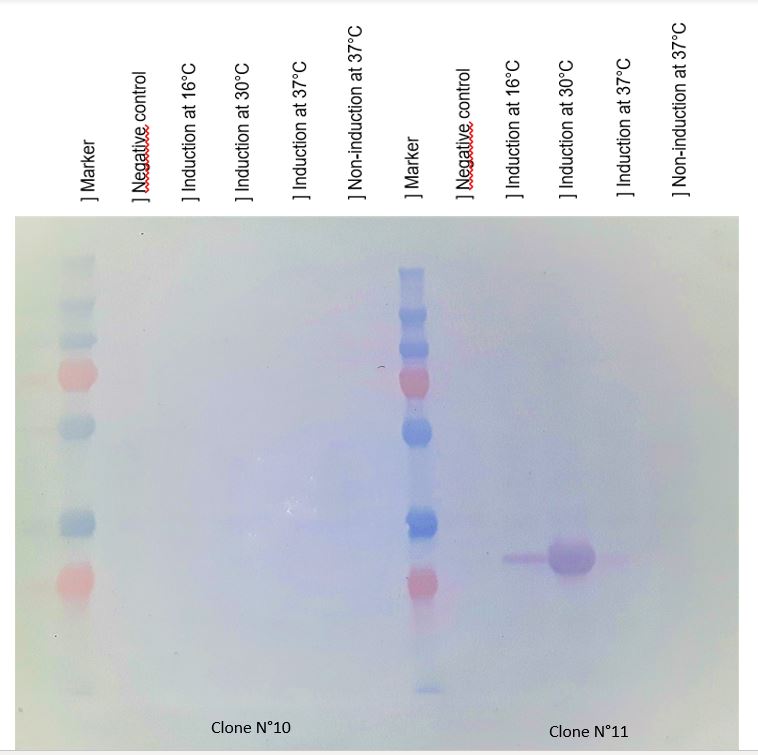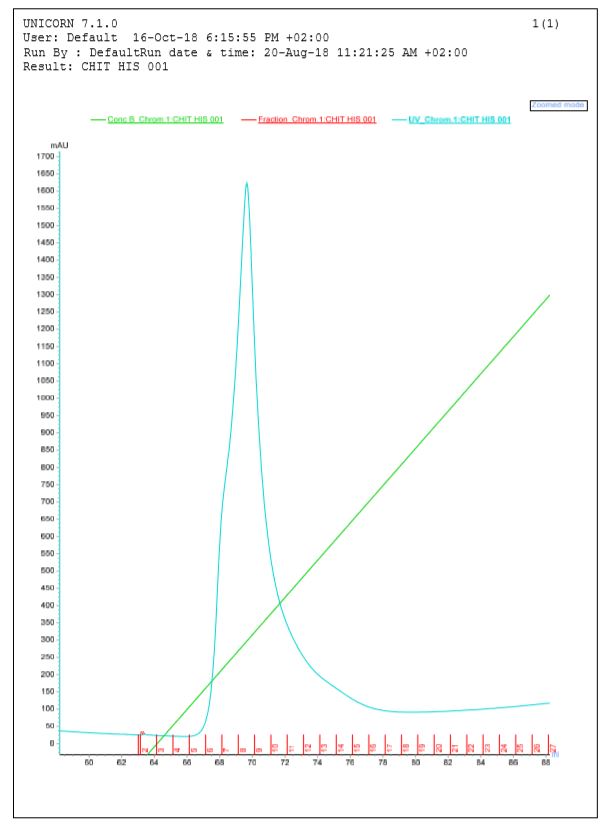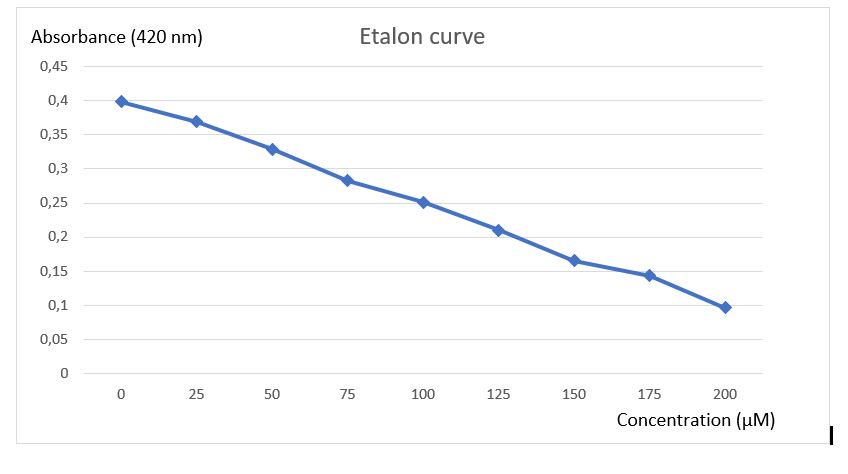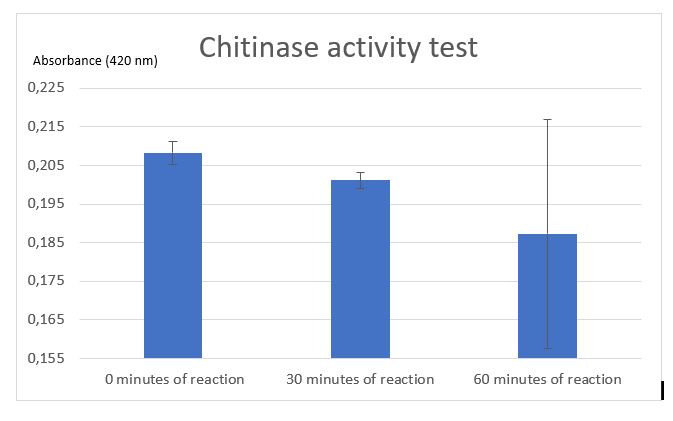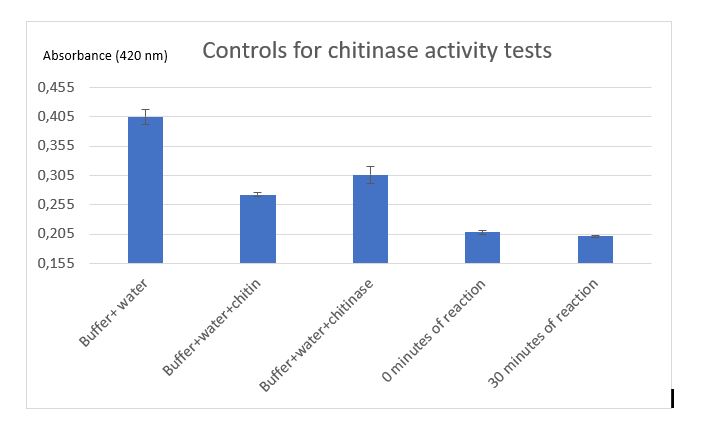(→Chitinase activity test) |
|||
| Line 61: | Line 61: | ||
==Mandelate synthase activity== | ==Mandelate synthase activity== | ||
| − | =Chitinase= | + | ==Chitinase== |
| + | |||
| + | === Chitinase production:=== | ||
| + | |||
| + | We achieve to produce chitinase thanks to our construction. An inducible overproduction by pLac promoter was used to study chitinase production, induction or none-induction experiments by IPTG can show the presence of the protein. We choose to produce chitinase by E. coli K-12 DH5-alpha strain. | ||
| + | For this two strains two differents recombinated plasmids with chit1 were tested, plasmid N°10 and N°11. | ||
| + | |||
| + | |||
| + | |||
| + | [[File:T--Aix-Marseille--ChitinaseResults13.jpg|600px|center|]] | ||
| + | |||
| + | '''''Ladder lengths for protein migration''''' | ||
| − | |||
| − | |||
| − | |||
| − | |||
[[File:T--Aix-Marseille--ChitinaseResults1.jpg|600px|center|]] | [[File:T--Aix-Marseille--ChitinaseResults1.jpg|600px|center|]] | ||
| − | Figure 1: Figure 1: SDS-PAGE of chitinase produced by | + | Figure 1: Figure 1: SDS-PAGE of chitinase produced by E. coli K-12 DH5-alpha. |
| − | |||
| − | |||
| − | |||
| − | |||
| − | |||
| − | + | As seen in Figure 1, a protein at the expected lenght (30 kDa) was overproduced only at 30°C after IPTG induction in DH5alpha. The non-induction by IPTG show an low band of the protein overproduced. This overproduction should be the chitinase, but it isn't normal that clone N°11 wasn't able to produced at least a significant chitinase quantity at 16°C and 37°C. We clarified that thanks to a western blot, to be sure of chitinase expression by clone N°11. | |
| − | + | ||
| + | [[File:T--Aix-Marseille--ChitinaseResults12.jpg|600px|center|]] | ||
| + | |||
| + | Figure 2 : Western blot with anti-HIS antibodies revelation | ||
| + | |||
| + | Chitinase output are better after IPTG induction at 30°C. This condition of culture will be used to produce in large quantity chitinase for purification and activity tests. | ||
| + | |||
| + | '''''(put file of western and blue of BL21 or not?)''''' | ||
| + | |||
| + | === Chitinase purification:=== | ||
| + | |||
| + | Chitinase designed had a polyhistidine-tag which allows it to be specifically separated among total proteins. A Akta purification was realized for purify Chit1. Akta Pure is a automated chromatography system for quick and easy purification. A nickel-nitrilotriacetic acid column was necessary to allow specifical interaction between histidines residues and metal ions from the nickel-nitrilotriacetic acid matrix. | ||
| + | |||
| + | In figure 3, a elution peak corresponding to the chitinase tagged is perceptible, but a light curve at first of elution peak is commensurate with contaminants peak. There isn't a separation of these two peaks therefore contaminants proteins and protein of interest are eluated jointly in the first elution samples. According to this graph and SDS-PAGE, chitinase is present in fraction 6 to 9, but this sample weren't completely pures, a lot of nonspecific proteins were recovered. An other purification is required for better purity, in this case we didn't have time to throw again a ppurification, and that wasn't indispensible for test activity tests. But we prove here that chitinase should be purified thank to its polyhistidine tag. | ||
| + | |||
| + | |||
| + | [[File:T--Aix-Marseille--ChitinaseResults11.jpg|600px|center|]] | ||
| + | |||
| + | Figure 3: Elution graph from chitinase purification | ||
| − | |||
| − | |||
| − | |||
| − | |||
[[File:T--Aix-Marseille--ChitinaseResults2.jpg|600px|center|]] | [[File:T--Aix-Marseille--ChitinaseResults2.jpg|600px|center|]] | ||
| − | Figure | + | Figure 4: SDS-PAGE of polyhistidine-tagged chitinase purification produced by E. coli K-12 DH5-alpha, using a nickel-nitrilotriacetic acid matrix. |
'''''(put markers lenghts on the image!!!! and indicate chitinase band )''''' | '''''(put markers lenghts on the image!!!! and indicate chitinase band )''''' | ||
| − | |||
| − | |||
| − | |||
| − | Numerous controls | + | Showed in figure 4, a protein at 30 kDa corresponding at the chitinase is obtained on bacteria lysate, on the non-purified fraction and on fraction N°6 to fraction N°10. This fractions can be pooled and used for activity tests. |
| − | + | Numerous controls has been done,chitinase was produced without its peptide signal of secretion, so it will be contained in the cytoplasm, the absence of the band at 30 kDa in the pellet verify that chitinase wasn't contained in the membrane. | |
| − | Bacteria lysate confirmed the presence of chitinase at 30kDa; non-purified migration shows a low quantity of chitinase with all proteins contaminants; | + | Bacteria lysate confirmed the presence of chitinase at 30kDa; non-purified migration shows a low quantity of chitinase with all proteins contaminants; break-though sample didn't contain the protein target demonstrating that all chitinase was fixed on nickel-nitrilotriacetic acid matrix. |
| − | The results of chitinase purification prove that chitinase can be purified thanks to its polyhistidine-tag. But purification wasn't optimal and can be | + | The results of chitinase purification prove that chitinase can be purified thanks to its polyhistidine-tag. But purification wasn't optimal and can be ameliorated because a lot of contaminants are isolated with chitinase. The nickel-nitrilotriacetic acid matrix column used was well-worn, that can reduced its efficiency. For an optimal separation of chitinase, we should pool eluate fractions containing chitinase and purify until reduce significantly protein contaminants. But without time we continued with this purification to do activity tests. |
| − | The nickel-nitrilotriacetic acid matrix column used was | + | |
| − | For an optimal separation of chitinase, we should pool eluate fractions containing chitinase and purify until reduce significantly protein contaminants. | + | |
| − | But | + | |
| − | |||
| − | |||
| − | |||
| − | |||
| − | |||
| − | |||
| − | To | + | |
| + | |||
| + | |||
| + | === Chitinase activity test:=== | ||
| + | |||
| + | Schales' procedure was used to test the chitinase activity. Schales' procedure is a colorimetric method commoly used for measuring the reducing sugars. | ||
| + | Chitin is composed of sugar units of either N-acetyl-G-glucosamine. Chitinase degrade chitin producing N-acetyl-G-glucosamine. To monitor chitinase activity, the reducing sugars released after chitin hydrolyse are detected by a color diminution of the yellow Shales' reagent. This color diminution is translated by a absorbance diminution. | ||
| + | |||
| + | |||
| + | To analyse activity test results, an etalon curve have been done using the final product of chitinase reaction (N-acetyl-G-glucosamine), to know in which concentration of final product must be obtained after reaction to be detected by the method of Schales. | ||
[[File:T--Aix-Marseille--ChitinaseResults3.jpg|600px|center|]] | [[File:T--Aix-Marseille--ChitinaseResults3.jpg|600px|center|]] | ||
| − | Figure | + | Figure 5: Etalon curve of N-acetyl-G-glucosamine after Schales's activity test. |
| + | |||
| + | A final curve has been obtain showing a absorbance diminution in function of increasing N-acetyl-G-glucosamine concentration. With this etalon curve, concentration of final product obtain after chitinase reaction can be determined. This results revealed the efficiency of Schales'procedure to detected N-acetyl-G-glucosamine to 0 at 200 uM. | ||
| − | |||
| − | |||
| − | |||
[[File:T--Aix-Marseille--ChitinaseResults9.jpg|600px|center|]] | [[File:T--Aix-Marseille--ChitinaseResults9.jpg|600px|center|]] | ||
| − | Figure | + | Figure 6: Table of absorbance measurements of chitinase activity test |
| + | |||
[[File:T--Aix-Marseille--ChitinaseResults4.jpg|600px|center|]] | [[File:T--Aix-Marseille--ChitinaseResults4.jpg|600px|center|]] | ||
| − | Figure | + | Figure 7: Chitinase activity test by Schales' procedure |
| + | |||
| + | According to figure 7, after 30 minutes of reaction a significant activity was mesured. But after 1 hour of reaction the standart deviation put in doubt the significant result at 30 minutes. One of the difficulties encountered was the chitin sample. Chitin sample wasn't completely dissolved in water, it was precipited and a lot of big fragments af shells of shrimps was contained making difficult the pippetage and with difficulty reproducibility. That's why an centrifugation step was added to avoid precipitated chitin to asborbe and affects the results. After centrifugation chitin wasn't really pelleted, it was easily removed. Chitin pellet should be removed in the duplicated sample of 1 hour after reaction, that can be the cause of the high standart deviation in the results. Due to limited time, we weren't able to do another activity test to improve the results and be the most careful at removing and may be we should centrigutated a longer time (not 1 minute but 5 minutes maybe). | ||
| + | |||
| + | |||
| + | Thanks to etalon curve if we consider only the significant results at 30 minutes, we can conclude that after 30 minutes of enzymatic reaction, our chitinase can released 125 uM of N-acetyl-G-glucosamine. | ||
| − | |||
| − | |||
| − | |||
| − | |||
| − | |||
| − | |||
| − | |||
| − | |||
| − | |||
[[File:T--Aix-Marseille--ChitinaseResults10.jpg|600px|center|]] | [[File:T--Aix-Marseille--ChitinaseResults10.jpg|600px|center|]] | ||
| − | Figure | + | Figure 8: Table of measurements of controls for chitinase activity test |
| + | |||
| + | |||
| + | |||
[[File:T--Aix-Marseille--ChitinaseResults5.jpg|600px|center|]] | [[File:T--Aix-Marseille--ChitinaseResults5.jpg|600px|center|]] | ||
| − | Figure | + | Figure 9: Controls for chitinase activity test |
'''''( comment the results of table and the graph!!!!!) ''''' | '''''( comment the results of table and the graph!!!!!) ''''' | ||
| + | |||
| + | |||
=Trap prototype tests= | =Trap prototype tests= | ||
Revision as of 15:36, 17 October 2018
Experiments
Experiments
Describe the research, experiments, and protocols you used in your iGEM project. These should be detailed enough for another team to repeat your experiments.
What should this page contain?
- Protocols
- Experiments
- Documentation of the development of your project
Beauveria bassiana
We did some research on Beavearia bassiana fungus because it's an entomopathogenic fungus used during years in agriculture, especially in Canada. [1]
So, we wanted to use this fungus to fight bed bugs which invade our homes. We selected and bought a Beauveria sample.
Growing Beauveria bassiana
First of all, we grew Beauveria bassiana fungus on three different kind of culture medium :
- LB with an antibiotic Cm50
- Sabouraud with Cm 50
- Sabouraud with collagen and Cm 50 [https://2018.igem.org/Team:Aix-Marseille/Protocols]
We made a serial dilution and let the fungus grow at three températures : 25°C, 30°C and 37°C. We obtained a lot of results but the culture medium and the most suitable temperature are the Sabouraud culture medium and 25°C. [2]
Killing insects with Beauveria bassiana
Secondly, we have tested Beauveria Sample on garden bugs with 4g of fungus sample diluted in 40ml of Tween 0,05% to confirmed that it was indeed Beauveria bassiana. We infected them by soaking and observed them for 2 weeks. Unfortunately, results obtained were inconclusive because we had problems keeping our control insect population alive.
However, we did observe mortality, and the infected bugs sprouted fungus a few days after the death of the insects. So, we decided to test our Beauveria Bassiana’s sample on bed bugs in real conditions.
Methionine gamma lyase
Methionine gamma lyase production
Methionine gamma lyase purification
Methionine gamma lyase activity
Mandelate synthase
Mandelate synthase production
Mandelate synthase activity
Chitinase
Chitinase production:
We achieve to produce chitinase thanks to our construction. An inducible overproduction by pLac promoter was used to study chitinase production, induction or none-induction experiments by IPTG can show the presence of the protein. We choose to produce chitinase by E. coli K-12 DH5-alpha strain. For this two strains two differents recombinated plasmids with chit1 were tested, plasmid N°10 and N°11.
Ladder lengths for protein migration
Figure 1: Figure 1: SDS-PAGE of chitinase produced by E. coli K-12 DH5-alpha.
As seen in Figure 1, a protein at the expected lenght (30 kDa) was overproduced only at 30°C after IPTG induction in DH5alpha. The non-induction by IPTG show an low band of the protein overproduced. This overproduction should be the chitinase, but it isn't normal that clone N°11 wasn't able to produced at least a significant chitinase quantity at 16°C and 37°C. We clarified that thanks to a western blot, to be sure of chitinase expression by clone N°11.
Figure 2 : Western blot with anti-HIS antibodies revelation
Chitinase output are better after IPTG induction at 30°C. This condition of culture will be used to produce in large quantity chitinase for purification and activity tests.
(put file of western and blue of BL21 or not?)
Chitinase purification:
Chitinase designed had a polyhistidine-tag which allows it to be specifically separated among total proteins. A Akta purification was realized for purify Chit1. Akta Pure is a automated chromatography system for quick and easy purification. A nickel-nitrilotriacetic acid column was necessary to allow specifical interaction between histidines residues and metal ions from the nickel-nitrilotriacetic acid matrix.
In figure 3, a elution peak corresponding to the chitinase tagged is perceptible, but a light curve at first of elution peak is commensurate with contaminants peak. There isn't a separation of these two peaks therefore contaminants proteins and protein of interest are eluated jointly in the first elution samples. According to this graph and SDS-PAGE, chitinase is present in fraction 6 to 9, but this sample weren't completely pures, a lot of nonspecific proteins were recovered. An other purification is required for better purity, in this case we didn't have time to throw again a ppurification, and that wasn't indispensible for test activity tests. But we prove here that chitinase should be purified thank to its polyhistidine tag.
Figure 3: Elution graph from chitinase purification
Figure 4: SDS-PAGE of polyhistidine-tagged chitinase purification produced by E. coli K-12 DH5-alpha, using a nickel-nitrilotriacetic acid matrix.
(put markers lenghts on the image!!!! and indicate chitinase band )
Showed in figure 4, a protein at 30 kDa corresponding at the chitinase is obtained on bacteria lysate, on the non-purified fraction and on fraction N°6 to fraction N°10. This fractions can be pooled and used for activity tests.
Numerous controls has been done,chitinase was produced without its peptide signal of secretion, so it will be contained in the cytoplasm, the absence of the band at 30 kDa in the pellet verify that chitinase wasn't contained in the membrane.
Bacteria lysate confirmed the presence of chitinase at 30kDa; non-purified migration shows a low quantity of chitinase with all proteins contaminants; break-though sample didn't contain the protein target demonstrating that all chitinase was fixed on nickel-nitrilotriacetic acid matrix.
The results of chitinase purification prove that chitinase can be purified thanks to its polyhistidine-tag. But purification wasn't optimal and can be ameliorated because a lot of contaminants are isolated with chitinase. The nickel-nitrilotriacetic acid matrix column used was well-worn, that can reduced its efficiency. For an optimal separation of chitinase, we should pool eluate fractions containing chitinase and purify until reduce significantly protein contaminants. But without time we continued with this purification to do activity tests.
Chitinase activity test:
Schales' procedure was used to test the chitinase activity. Schales' procedure is a colorimetric method commoly used for measuring the reducing sugars. Chitin is composed of sugar units of either N-acetyl-G-glucosamine. Chitinase degrade chitin producing N-acetyl-G-glucosamine. To monitor chitinase activity, the reducing sugars released after chitin hydrolyse are detected by a color diminution of the yellow Shales' reagent. This color diminution is translated by a absorbance diminution.
To analyse activity test results, an etalon curve have been done using the final product of chitinase reaction (N-acetyl-G-glucosamine), to know in which concentration of final product must be obtained after reaction to be detected by the method of Schales.
Figure 5: Etalon curve of N-acetyl-G-glucosamine after Schales's activity test.
A final curve has been obtain showing a absorbance diminution in function of increasing N-acetyl-G-glucosamine concentration. With this etalon curve, concentration of final product obtain after chitinase reaction can be determined. This results revealed the efficiency of Schales'procedure to detected N-acetyl-G-glucosamine to 0 at 200 uM.
Figure 6: Table of absorbance measurements of chitinase activity test
Figure 7: Chitinase activity test by Schales' procedure
According to figure 7, after 30 minutes of reaction a significant activity was mesured. But after 1 hour of reaction the standart deviation put in doubt the significant result at 30 minutes. One of the difficulties encountered was the chitin sample. Chitin sample wasn't completely dissolved in water, it was precipited and a lot of big fragments af shells of shrimps was contained making difficult the pippetage and with difficulty reproducibility. That's why an centrifugation step was added to avoid precipitated chitin to asborbe and affects the results. After centrifugation chitin wasn't really pelleted, it was easily removed. Chitin pellet should be removed in the duplicated sample of 1 hour after reaction, that can be the cause of the high standart deviation in the results. Due to limited time, we weren't able to do another activity test to improve the results and be the most careful at removing and may be we should centrigutated a longer time (not 1 minute but 5 minutes maybe).
Thanks to etalon curve if we consider only the significant results at 30 minutes, we can conclude that after 30 minutes of enzymatic reaction, our chitinase can released 125 uM of N-acetyl-G-glucosamine.
Figure 8: Table of measurements of controls for chitinase activity test
Figure 9: Controls for chitinase activity test
( comment the results of table and the graph!!!!!)
Trap prototype tests
(put the protocol of trap tests!!!)



